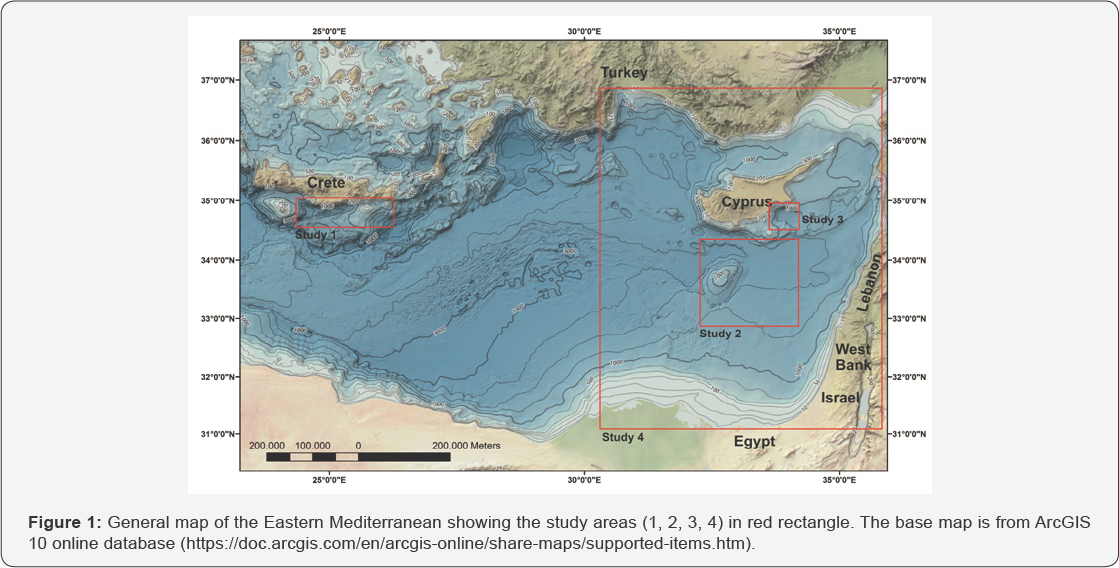Latest Developments in Oil Spill Modelling in the Eastern Mediterranean Sea- Juniper publishers
Juniper Publishers- Journal of Oceanography and Fisheries
Latest Developments in Oil Spill Modelling in the Eastern Mediterranean Sea
Alves TM1, Kokinou E2*, Zodiatis G3, Lardner R3, Panagiotakis C4 and Radhakrishnan H3
13D Seismic Lab- School of Earth and Ocean Sciences, Cardiff University, UK
2Department of Environmental and Natural Resources Engineering, Technological Educational Institute Crete, Greece
3Oceanography Centre, University of Cyprus, Cyprus
4Department of Business Administration, Technological Educational Institute Crete, Greece
Submission: February 17, 2017; Published: March 24, 2017
*Corresponding author: Kokinou E, Department of Environmental and Natural Resources Engineering, Technological Educational Institute Crete, 3 Romanou Str. Chalepa, Chania, Crete GR 73133, Greece, Email: ekokinou@staff.teicrete.gr
How to cite this article: Alves T, Kokinou E, Zodiatis G, Lardner R, Panagiotakis C, Radhakrishnan H. Latest Developments in Oil Spill Modelling in the Eastern Mediterranean Sea. Ocean & fish Open Access J. 2017; 1(4): 555569. DOI: 10.19080/OFOAJ.2017.01.555569
Mini Review
Oil spills resulting from offshore drilling or maritime traffic are major environmental threat for marine life and human coastal communities, particularly in confined seas such as the Mediterranean, Black and Baltic seas. The management of oil spills by the civil protection teams is generally difficult because their movement is related to factors such as local oceanographic- meteorological conditions, sea floor topography and coastal geomorphology, as well as to the physical and chemical characteristics of the oil released. These factors were taken into account in a methodology developed under the umbrella of European Commission projects concerning oil spill response and predictions in the Mediterranean (www.nereids.eu, www. medess4ms.eu, www.raop.eu, www.emodnet-mediterranean. eu), aiming at understanding oil spill movement and scattering in offshore regions where exploration drilling is equated or heavy marine traffic takes part.

Four studies (Figure 1) in the Eastern Mediterranean were implemented in recent years to suggest the best practices to civil protection authorities for controlling and cleaning near shore or remote oil spills, either maritime or platform related. The first study [1] concluded that high to very-high risk zones around the island of Crete are related to offshore bathymetric features, shoreline geology and the presence near the shore of sedimentary basins filled with unconsolidated deposits of high permeability. Based on the prevailing weather and oceanographic conditions in Crete (Greece) region, oil spills are expected to reach the shoreline 5 to 72 hours after the initial accident. A total of 104 oil spill simulations were computed in the context of the second study [2] for 11 different locations in the Levantine Basin, predicting that oil slicks will reach the coast of Cyprus in four (4) to six (6) days. Furthermore, the use of chemical dispersants in the very few hours after large accidental oil spills was supported by this latter work. In a third study, oil spill scenarios were produced for the southern coast of Cyprus [3] resulting from the need to predict oil spill dispersion after new oil terminals and depots were built. Among the most important findings is the reduction from 84% to 9% in the volume of oil trapped on the coast if dispersants are applied, with the latter 9% being potentially kept at bay using booms and mechanical removal techniques. Finally, in our latest research article [4] oil spill simulations for 19 existing offshore wells were carried out showing a trend for east and northeast movement of oil spills into the Levantine Basin, affecting primarily the coastal areas of Egypt, Israel, Lebanon and Syria. Oil slicks will reach the coast in 1 to 20 days, driven by the action of the winds, currents and waves. Seabed morphology seems to be associated with the direction of the oil slick expansion, altering the movement of sea currents. Oil spills in the Eastern Mediterranean Sea should be mitigated in the very few hours after their onset, and before wind and currents disperse them and protocols should be prioritised between neighbouring countries to mitigate any oil spills.
In conclusion, the Eastern Mediterranean Sea is undergoing a large scale expansion in every economic activity related to the near-shore and offshore marine environments, including Oil & Gas exploration and maritime traffic. However, existing and planned activities can have a devastating effect on the livelihoods and economy of coastal regions in the Eastern Mediterranean. It is more necessary than ever the establishment of cross-border civil protection and marine pollution cooperation amongst neighbouring countries, so that direct responses to man-made disasters are based on specific technical skills or know-how.
To Know More About Oceanography & Fisheries Open Access Journal Please Click on: https://juniperpublishers.com/ofoaj/index.php
To Know More About Open Access Journals Publishers Please Click on: Juniper Publishers
Comments
Post a Comment